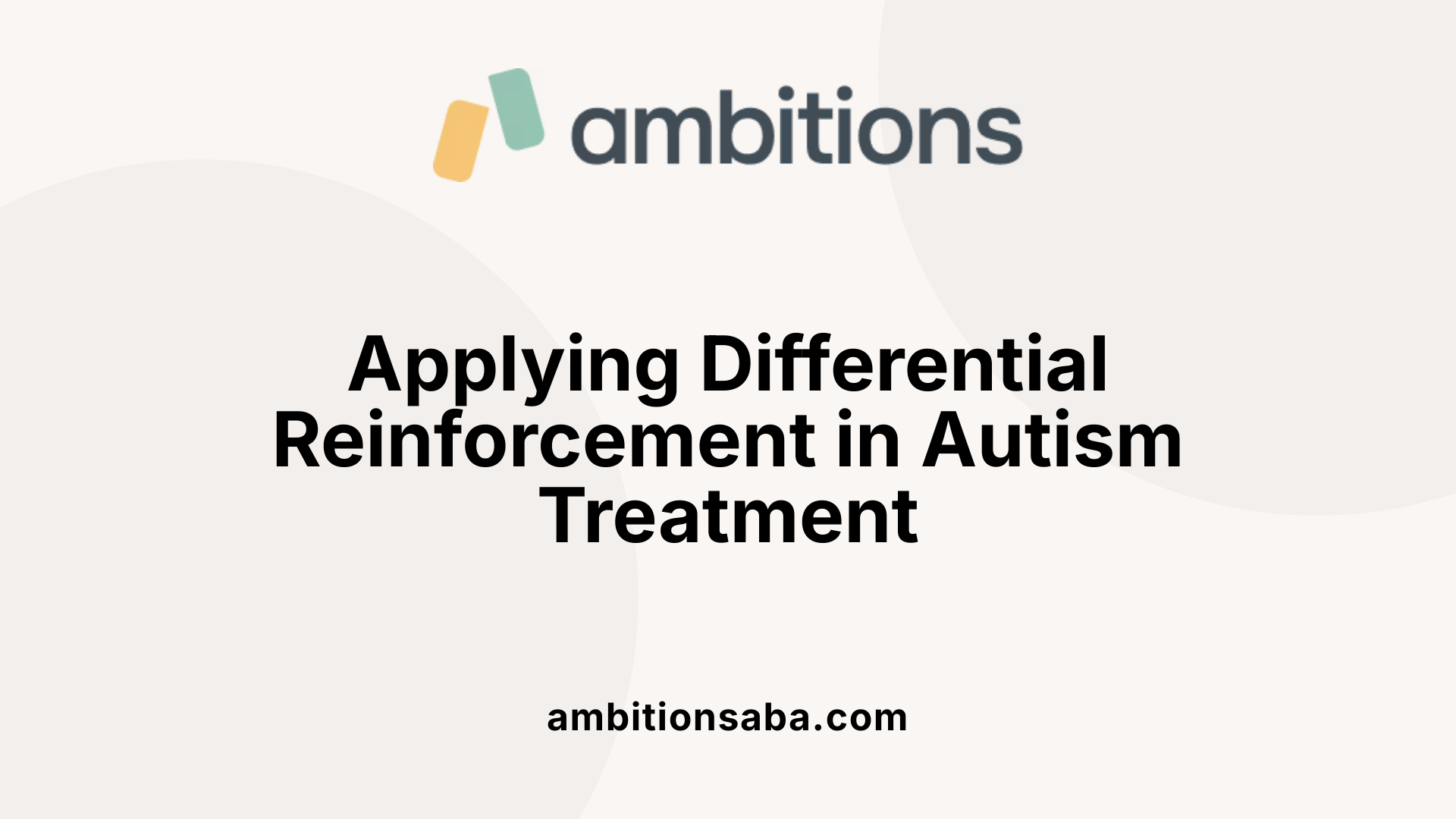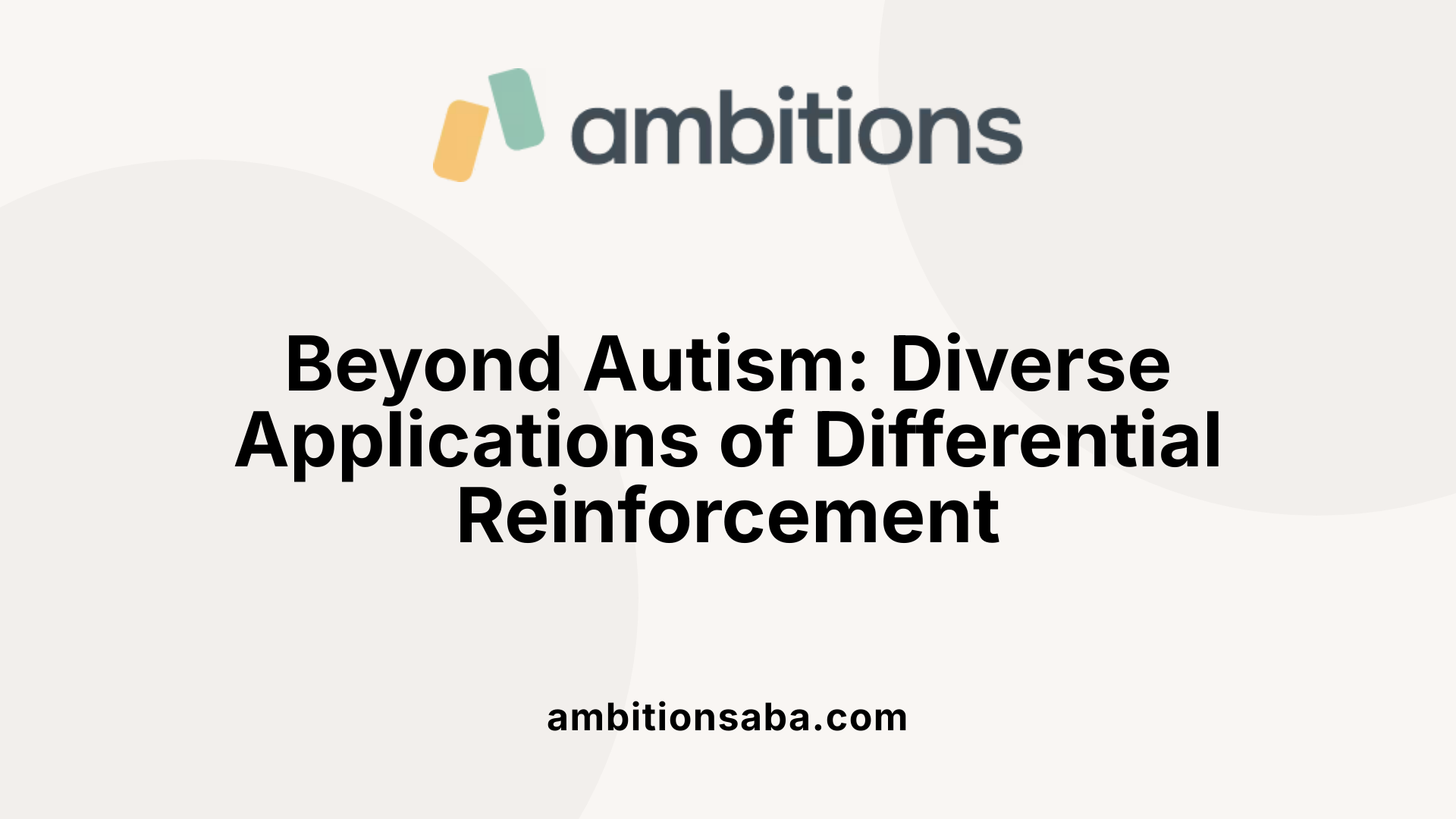Bridging Cultures and Care: Enhancing ABA Therapy Through Cultural Competence
Understanding Differential Reinforcement in Behavioral Therapy
Differential reinforcement is a cornerstone technique within Applied Behavior Analysis (ABA), a scientifically validated therapy widely used to support individuals with Autism Spectrum Disorder (ASD). By selectively encouraging desired behaviors and discouraging unwanted ones, differential reinforcement facilitates meaningful behavioral change. This article explores what differential reinforcement is, its various types, and its practical applications, especially in the context of autism therapy and beyond.
What Is Differential Reinforcement?

Definition of differential reinforcement
Differential reinforcement is a behavior modification technique used within Applied Behavior Analysis (ABA) therapy. It involves selectively reinforcing desired behaviors while withholding reinforcement for undesired ones. This approach encourages the increase of positive behaviors by rewarding them and decreases unwanted behaviors by not providing reinforcement. The goal is to shape behavior by strategically responding to what is appropriate and ignoring or minimizing reinforcement for what is not.
Underlying principles in behavior modification
The foundation of differential reinforcement lies in operant conditioning, a learning principle developed by B. F. Skinner. By differentially reinforcing behaviors, practitioners manipulate the environment so that behaviors serving the same function as problematic ones can replace them. There are several types of differential reinforcement:
- DRA (Differential Reinforcement of Alternative Behavior): Reinforces socially acceptable alternatives.
- DRI (Differential Reinforcement of Incompatible Behavior): Reinforces behaviors that cannot co-occur with the problem behavior.
- DRO (Differential Reinforcement of Other Behavior): Reinforces the absence of the problem behavior for a period.
- DRL (Differential Reinforcement of Low Rates): Reinforces reduced frequency of a behavior.
These techniques involve carefully planned rewards to increase appropriate actions and reduce maladaptive ones.
Role in ABA therapy
Differential reinforcement is a core strategy in ABA therapy, especially for individuals with Autism Spectrum Disorder (ASD). It helps promote essential skills such as social interaction, communication, and self-help abilities by reinforcing positive behaviors and reducing challenging ones. For example, reinforcing appropriate eye contact or functional communication replaces problematic behaviors. ABA therapists use differential reinforcement alongside assessments to tailor interventions and ensure consistent, immediate reinforcement to maximize effectiveness. Because ABA therapy is evidence-based and based on behavioral science principles, differential reinforcement remains fundamental in behavior change programs across clinical, educational, and even workplace settings.
Key Principles Underpinning Differential Reinforcement in ABA

What are the key principles behind ABA therapy?
Applied Behavior Analysis (ABA) is grounded in scientific principles that focus on understanding behavior within its environmental context. Core to ABA is the use of data-driven interventions that emphasize observable and socially significant behaviors. Practitioners apply validated techniques such as reinforcement, prompting, shaping, and modeling to both increase desirable behaviors and reduce problematic ones.
ABA interventions are individualized, relying heavily on Functional Behavior Assessments (FBA) to identify the purposes behind behaviors. This ensures that treatment plans are tailored effectively to each person's unique needs.
Behavioral principles behind differential reinforcement
Differential reinforcement hinges on selectively reinforcing positive, appropriate behaviors while withholding reinforcement for undesired ones. This approach manipulates reinforcement schedules to increase the frequency of desired actions and decrease problematic behaviors.
There are several variations of differential reinforcement used in ABA:
- Differential Reinforcement of Alternative behavior (DRA): Reinforces socially acceptable behaviors that serve as alternatives to the problem behavior.
- Differential Reinforcement of Incompatible behavior (DRI): Reinforces behaviors that physically cannot occur at the same time as the unwanted behavior.
- Differential Reinforcement of Other behavior (DRO): Provides reinforcement when the problematic behavior does not occur for a set interval.
- Differential Reinforcement of Low rates (DRL): Encourages reduction in behavior that is excessive but not inappropriate.
Use of reinforcement and punishment
ABA employs both reinforcement and punishment strategically to modify behaviors.
- Positive reinforcement adds desirable stimuli (e.g., praise, tokens) to increase desired behaviors.
- Negative reinforcement involves removing aversive stimuli when a positive behavior occurs.
- Positive punishment adds an aversive stimulus to reduce undesired behavior.
- Negative punishment takes away a pleasant stimulus (e.g., toy removal) to decrease problematic behavior.
Through careful application of these principles, ABA practitioners work to shape behaviors in a systematic and ethical manner, aiming for meaningful and lasting improvements.
Scientific foundation of ABA
ABA’s foundation lies in operant conditioning principles first developed by B. F. Skinner. It has evolved into a mature discipline supported by extensive research demonstrating effectiveness, particularly for individuals with Autism Spectrum Disorder (ASD). Although rigorous randomized controlled trials (RCTs) are few, meta-analyses consistently report improvements across various developmental domains such as language, social skills, and adaptive behaviors.
The core ABA dimensions—being applied, behavioral, analytic, technological, effective, and general—guide interventions ensuring they are both evidence-based and replicable. With differential reinforcement serving as a cornerstone technique, ABA continues to be a leading method for behavior modification and skill acquisition.
Types of Differential Reinforcement Explained
Differential Reinforcement of Alternative Behavior (DRA)
DRA focuses on encouraging a socially acceptable alternative to a problematic behavior. For example, instead of a child throwing objects, DRA would reinforce calm expressions or polite requests. This technique helps the individual learn a more appropriate way to meet the same need or function previously served by the undesirable behavior.
Differential Reinforcement of Incompatible Behavior (DRI)
DRI involves reinforcing behaviors that cannot happen simultaneously with the unwanted behavior. For instance, if a child tends to hit others, reinforcing the behavior of playing with a toy instead is a form of DRI. Since the child cannot hit and play with a toy at the same time, the problematic behavior naturally decreases.
Differential Reinforcement of Other Behavior (DRO)
DRO reinforces any behavior that is not the undesired one. When there is no specific alternative behavior identified, DRO rewards the absence of the problem behavior during set periods. An example would be rewarding a child for sitting quietly without trying to leave their seat for a specific amount of time.
Differential Reinforcement of Low Rates (DRL)
DRL is used when a behavior is not necessarily inappropriate but occurs excessively. It encourages reducing the frequency of that behavior to more acceptable levels. For example, if a child washes their hands too often, DRL reinforces occasions when the frequency of hand washing is lower than a set limit.
These differential reinforcement strategies are crucial in Applied Behavior Analysis (ABA) for promoting positive behaviors and reducing unwanted ones, especially among individuals with Autism Spectrum Disorder (ASD) and in various other settings like education and workplaces.
How Differential Reinforcement is Applied in Autism Therapy

How does ABA therapy help individuals with autism?
ABA therapy aids individuals with autism by analyzing how their behaviors are influenced by their environment and learning processes. It targets increasing beneficial behaviors such as communication, social interactions, and daily living skills while decreasing harmful or unproductive behaviors using positive reinforcement and evidence-based methods. Programs are customized according to each person's unique needs, with progress tracked by certified behavior analysts.
Use of differential reinforcement to improve social and communication skills
Differential reinforcement is a foundational strategy within ABA that selectively reinforces desired social and communication behaviors. This method encourages individuals with autism to develop appropriate interactions by rewarding actions like making eye contact or using functional language during communication. By offering positive reinforcement immediately after the target behavior, therapists help solidify these crucial social skills.
Examples in autism treatment such as eye contact and functional communication
Specific examples of differential reinforcement in autism therapy include reinforcing eye contact, which is often challenging for many individuals with ASD. Therapists might praise or provide tangible rewards when a child makes intentional eye contact during conversation. Similarly, functional communication is encouraged by reinforcing verbal requests or alternative communication methods that replace problematic behaviors, such as tantrums or aggression.
Role in promoting self-help tasks
Beyond social and communication skills, differential reinforcement also supports the acquisition of self-help abilities. Tasks like dressing, feeding, and hygiene routines are targeted by reinforcing each successful attempt or completion. This process boosts independence and daily functioning, which are essential for improving quality of life among individuals with autism.
Overall, differential reinforcement within ABA therapy systematically encourages positive behaviors while reducing disruptive ones, leading to improvements across social, communication, and personal care domains for individuals with autism.
The Role of Professionals Delivering Differential Reinforcement
Who typically provides ABA therapy?
ABA therapy, including differential reinforcement techniques, is primarily delivered by trained and certified professionals. The cornerstone practitioners are Board Certified Behavior Analysts (BCBAs), who design individualized treatment plans and oversee therapy implementation. They employ their expertise to apply behavioral principles such as reinforcement strategies effectively.
Registered Behavior Technicians (RBTs) or behavior therapists operate under BCBA supervision to provide direct interventions, applying differential reinforcement methods in real-time. Other qualified professionals like Board Certified Assistant Behavior Analysts (BCaBAs) and Qualified Behavioral Analysts (QBAs) may also be involved, depending on the service environment and client needs.
Training and certification of practitioners
To ensure high-quality care, ABA providers undergo specialized training in behavior analysis techniques, including differential reinforcement. Certification processes require comprehensive coursework, supervised practical experience, and passing certification exams. These rigorous standards prepare practitioners to analyze behavior functionally and implement evidence-based treatments targeting behaviors effectively.
Collaborative roles in therapy delivery
Delivering effective ABA therapy often involves a collaborative approach. Professionals routinely work alongside parents, educators, and other healthcare providers to integrate strategies like differential reinforcement into daily activities. This team coordination enhances consistency and promotes skill generalization across varied settings such as home, school, and community environments.
This collective effort ultimately ensures individuals, particularly children with Autism Spectrum Disorder, benefit from tailored interventions promoting appropriate behaviors and functional skills.
Measuring Success: How Progress is Evaluated in Differential Reinforcement
How is progress measured in ABA therapy sessions?
Progress in ABA therapy, particularly when using differential reinforcement, centers on consistent and systematic data collection. Therapists carefully observe and record the frequency, intensity, and duration of targeted behaviors to understand how the individual’s responses evolve over time. This observational data is often supplemented by checklists and rating scales designed to capture both specific skill acquisition and reductions in undesired behaviors.
Data collection strategies in ABA
Critical to measuring progress is the use of various data collection methods. These include:
- Direct observation: Recording behavior as it occurs in therapy or natural settings.
- Functional Behavior Assessment (FBA): Identifies the purpose of challenging behaviors.
- Preference and Reinforcer Assessments: Determine which stimuli motivate the individual, enhancing reinforcement strategies.
Electronic systems may be employed to document this data systematically, promoting accuracy and timely analysis.
Assessment tools used to monitor behavioral change
Several assessment tools guide monitoring behavioral changes:
| Assessment Tool | Purpose | Application Example |
|---|---|---|
| Functional Behavior Assessment (FBA) | Identifies function of a behavior | Guides intervention development |
| Skills Assessment | Measures acquisition of target skills | Tracks gains in communication or social behavior |
| Reinforcer Assessment | Finds effective reinforcers | Optimizes reinforcement delivery |
These tools enable therapists to tailor interventions such as Differential Reinforcement of Alternative Behavior (DRA) or Differential Reinforcement of Incompatible Behavior (DRI) appropriately.
Adjusting treatment based on progress
Therapists continuously analyze collected data to evaluate the effectiveness of differential reinforcement techniques. If desired behaviors increase and undesired behaviors decrease, reinforcement strategies may be gradually faded or schedules thinned to promote independence. Conversely, if progress stalls, intervention plans are revisited to modify reinforcement types or intensities.
Overall, evaluating progress through detailed data collection, careful assessment, and responsive treatment adjustments is essential for successful outcomes in differential reinforcement within ABA therapy.
Beyond Autism: Differential Reinforcement in Other Settings

How is differential reinforcement applied outside the autism context?
Differential reinforcement techniques extend well beyond autism therapy to a variety of everyday settings, including education, parenting, and the workplace. By selectively reinforcing positive behaviors and withholding reinforcement for undesirable ones, it offers a practical approach for behavior management across diverse populations.
What are some specific applications in education, parenting, and workplace?
- Education: Teachers use differential reinforcement to promote positive classroom behaviors, such as praising students for raising hands or completing assignments. This encourages engagement and reduces disruptive conduct.
- Parenting: Parents can reinforce desirable child behaviors like sharing or following instructions while ignoring or redirecting negative behaviors, helping shape appropriate social skills.
- Workplace: Supervisors may reinforce punctuality and cooperation among employees by providing rewards or recognition, thereby improving productivity and morale.
How adaptable is differential reinforcement?
Differential reinforcement is highly adaptable. Its core principles can be modified depending on the population, targeted behaviors, and environmental context. Whether reinforcing alternative behaviors (DRA), incompatible behaviors (DRI), or rewarding absence of problematic behaviors (DRO), these techniques are versatile tools to manage behavior effectively.
Why is differential reinforcement useful for behavior management across populations?
Its utility lies in its focus on reinforcing positive alternatives rather than punishing negative behaviors exclusively. This strategy promotes sustainable behavior change, enhances skill acquisition, and supports positive social interactions among children, adults, or individuals with different needs.
Overall, differential reinforcement presents a flexible and effective framework for encouraging desirable behaviors in many real-world environments beyond autism treatment.
Common Misconceptions About Differential Reinforcement and ABA
Clarifying myths about punishment versus reinforcement
One widespread myth about ABA therapy is that it mainly uses punishment to control behavior. In truth, ABA heavily emphasizes positive reinforcement — rewarding desirable behaviors to encourage their recurrence. Techniques like differential reinforcement focus on reinforcing appropriate behaviors while withholding reinforcement for inappropriate ones, steering clear of punishment-focused methods. When punishment is used, ethical guidelines strictly regulate it, making positive and supportive strategies the cornerstone of ABA.
The holistic goal of ABA beyond behavior reduction
Many assume ABA's only purpose is to reduce problematic behaviors, but its goals are much broader. ABA teaches new skills in communication, social interaction, and self-help, promoting overall independence and quality of life. For example, differential reinforcement not only discourages unwanted behaviors but also strengthens alternative or incompatible behaviors, enhancing functional abilities. ABA is tailored to individuals’ unique needs, aiming to empower rather than merely suppress behaviors.
Ethical and supportive nature of therapy approaches
There's a misconception that ABA employs harsh or inflexible methods. Modern ABA practices are ethical and person-centered, focusing on supportive interventions. Differential reinforcement techniques are designed to be positive and immediate, ensuring learning is both effective and compassionate. Practitioners are trained to apply reinforcement consistently and patiently, creating a nurturing environment where progress is encouraged through encouragement rather than punishment.
Together, these points highlight that ABA—and differential reinforcement by extension—is a scientifically grounded, ethical, and supportive approach, not a punishment-based or rigid system. It centers on improving individuals’ skills and enhancing their lives through reinforcement and personalized care.
Research and Evidence Supporting Differential Reinforcement in ABA
What is the historical development of ABA?
Applied Behavior Analysis (ABA) traces its roots to operant conditioning principles developed by B.F. Skinner. In the 1970s, Ole Ivar Lovaas significantly advanced ABA by demonstrating that intensive behavioral interventions could produce substantial developmental improvements in children with Autism Spectrum Disorder (ASD). His early studies reported that roughly 47% of children undergoing intensive ABA reached typical intellectual and educational functioning, compared to just 2% in control groups.
What does research say about the outcomes and effectiveness of ABA?
Contemporary ABA includes models like Early Intensive Behavioral Intervention (EIBI), Early Start Denver Model (ESDM), and LEAP, which collectively target cognition, language, and social skills. Meta-analyses generally support ABA's positive effects on language development, social functioning, and adaptive behaviors. Although randomized controlled trials (RCTs) are limited, existing studies suggest meaningful improvements in various functional areas for individuals receiving ABA therapy.
What gaps exist in current research?
Despite promising findings, only a small percentage of studies rigorously assess ABA's impact using direct comparison groups without relying solely on mastery criteria. Notably, there is a lack of research focusing on the quality of life (QoL) for children with ASD following ABA interventions. Such outcomes are critical for understanding the real-world benefits and challenges of therapy beyond clinical measures.
Why are longitudinal studies necessary?
To better understand the long-term effects and overall efficacy of ABA and differential reinforcement strategies, there is a clear need for large-scale, prospective, longitudinal studies. These should include comparisons with newer interventions and incorporate QoL metrics to provide a more comprehensive evaluation of benefits. This body of research will help refine best practices and optimize interventions for individuals with ASD.
The Transformative Power of Differential Reinforcement
Differential reinforcement stands as a fundamental and versatile technique within ABA therapy, pivotal in shaping positive behaviors and mitigating challenges in individuals with autism and beyond. Rooted in robust behavioral principles and supported by decades of research, its application continues to evolve, demonstrating effectiveness in fostering communication, social skills, and independence. Understanding its types and strategic use empowers caregivers and professionals to implement tailored interventions that respect individuality and promote meaningful growth. While research advances and misconceptions are addressed, differential reinforcement remains a beacon of hope and progress in behavioral therapy, enabling better quality of life for those it serves.
References
- What is Differential Reinforcement? Exploring its Applications
- What is Differential Reinforcement?
- Applied Behavior Analysis in Children and Youth with Autism ...
- Differential reinforcement procedures. - APA PsycNet
- Differential Reinforcement ABA Strategies
- Pediatric ABA Therapy: Guide to When, Why & How Much?
- Progress Monitoring - Screening and Assessment
- Applied Behavior Analysis (ABA)
- The Top 10 Reasons Children With Autism Deserve ABA
- Applied Behavior Analysis (ABA)

